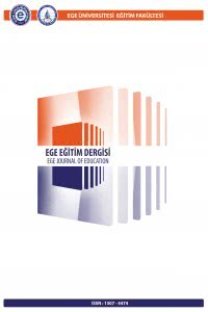MESLEK LİSESİ ÖĞRENCİLERİNİN SİBER AYLAKLIK DÜZEYİNİN FARKLI DEĞİŞKENLERE GÖRE İNCELENMESİ
Siber aylaklık, meslek lisesi öğrencileri, sosyal ağlar, akıllı telefon
___
- Adams, D. (2006). Wireless labtops in the classroom (and the Susame Street syndrome). Communication of the ACM, 49(9), 25-27. doi: 10.1145/1151030.1151049
- Akbulut, Y., Dursun, Ö. Ö., Dönmez, O., ve Şahin, Y. L. (2016). In search of a measure to investigate cyberloafing in educational settings. Computers in Human Behavior, 55, 616–625. http://doi.org/10.1016/j.chb.2015.11.002
- Arabaci, B. (2017). Investigation faculty of education students’ cyberloafing behaviors in terms of various variables. Turkish Online Journal of Educational Technology, 16(1), 72–82.
- Bağrıaçık Yilmaz, A. (2017). Lisansüstü Öğrencilerinin Siber Aylaklık Düzeylerinin Çeşitli Değişkenler Açısından İncelenmesi : Karma Bir Çalışma. Ahi Evran Üniversitesi Kırşehir Eğitim Fakültesi Dergisi, 18 (2), 113–134.
- Baker, W.M., Lusk, E.J., ve Neuhauser, K.L. (2012). On the use of cell phones and other electronic devices in the classroom: Evidence from a survey of faculty and students. Journal of Education for Business, 87, 275-289.
- Baturay, M.H. ve Toker, S. (2015). An investigation of theimpact of demographics on cyberloafing from an educationalsettingangle. Computers in Human Behavior, 50 (2015) 358–366.
- Blanchard, A. L., ve Henle, C. A. (2008). Correlates of different forms of cyberloafing: The role of norms and external locus of control. Computers in Human Behavior, 24(3), 1067–1084.
- Brubaker, A. T. (2006). Faculty perceptions of the impact of student laptop use in a wireless internet environment on the classroom learning environment and teaching information and library science. (Yayımlanmamış Yüksek Lisans Tezi). University of North Carolina, Chapel Hill.
- Bugeja, M. (2008). The age of distraction: The professor or the processor? The Futurist, 42(1), 66–68.
- Chang, M. K. ve Law, S. P. M. (2008). Factor structure for young‟s internet addiction test: A confirmatory study. Computers in Human Behavior, 24(6), 2597–2619.
- Doğan, U., & Karakaş, Y. (2016). Lise öğrencilerinin sosyal ağ sitleri kullanımının yordayıcısı olarak yalnızlık. Sakarya University Journal of Education, 6(1), 57-71.
- Doorn, O. N. (2011). Cyberloafing: A multi-dimensional construct placed in a theoretical framework. (Yayımlanmış Yüksek Lisans tezi). Eindhoven University of Technology, Holland.
- Draude, B. ve Brace, S. (1999). Assessing the impact of technology on teaching and learning: Student perspectives. Proceedings of the Mid-South Instructional Technology Conference, Murfreesboro, TN.
- Dursun, Ö.Ö., Akbulut, Y. ,Dönmez, O.&İ. Şahin, Y.L. (2015). Bilişim teknolojileri öğretmen adaylarının siber aylaklık profillerinin belirlenmesi. 3rd. International Instructional Technologies& Teacher Education Symposium.Karadeniz Technical University.09-11 September 2015, Trabzon-Turkey
- Ergün, E., ve Altun, A. (2012). Öğrenci Gözüyle Siber Aylaklık ve Nedenleri. Eğitim Teknolojisi Kuram ve Uygulama, 2(2), 36-51.
- Fraenkel, J. R., Wallen, N. E., & Hyun, H. H. (2012). How to design and evaluate research in education. New York, N.Y.; London: McGraw-Hill Higher Education.
- Galluch, P. S., & Thatcher, J. B. (2006,Kasım). Slacking and the internet in the classroom: A prelimary investigation. Proceedings of the fifth annual workshop on HCI research in MSI, Milwaukee, Wisconsin
- Garrett, R. K., & Danziger, J. N. (2008). Disaffection or expected outcomes: Understanding personal Internet use during work. Journal of Computer‐Mediated Communication, 13(4), 937-958.
- Gökçearslan, Ş., Mumcu, F. K., Haşlaman, T., ve Çevik, Y. D. (2016). Modelling smartphone addiction: The role of smartphone usage, self-regulation, general self-efficacy and cyberloafing in university students. Computers in Human Behavior, 63(June), 639–649. http://doi.org/10.1016/j.chb.2016.05.091
- Hartijasti, Y., ve Fathonah, N. (2014). Cyberloafing across generation X and Y in Indonesia. Journal of Information Technology Applications & Management, 21(1), 1–16.
- Hembrooke, H. ve Gay G. (2003). The laptop and the lecture: The effects of multitasking in learning environments. Journal of Computing in Higher Education, 15, 46-64.
- Kalaycı, E. (2010). Üniversite Ögrencilerinin Siberaylaklık Davranışları ile Öz Düzenleme Stratejileri Arasındaki Ilişkinin İncelenmesi. (Yayımlanmamış Yüksek Lisans Tezi). Hacettepe Üniversity, Ankara.
- Karaoğlan Yılmaz, F. G., Yılmaz, R., Öztürk, H. T., Sezer, B., ve Karademir, T. (2015). Cyberloafing as a barrier to the successful integration of information and communication technologies into teaching and learning environments. Computers in Human Behavior, 45(April 2015), 290–298.
- Keser, H., Kavuk, M.,& Numanoğlu, G. (2016). The Relationship between Cyber-Loafing and internet addiction.Cypriot Journal of Educational Science. 11(1), 37-42.
- Knight, R. M. (2017). Academic cyberloafing: a study of perceptual and behavioral differences on in-class cyberloafing among undergraduate students. (Yayımlanmamış yüksek lisans tezi). East Carolina University, ABD.
- Kurt, M. (2011). Siber Aylaklık Davranışlarının Karşılaştırmalı Olarak İncelenmesi. Sözel bildiri, 5th International computer & instructional technologies symposium, 22–24 September 2011, Elazığ.
- Lim, V. G. K. (2002). The IT way of loafing on the job: cyberloafing, neutralizing and organizational justice. Journal of Organizational Behavior, 23, 675–694.
- Mastrangelo, P. M., Everton, W., ve Jolton, J. A. (2006). Personal use of work computers: Distraction versus destruction. CyberPsychology & Behavior, 9(6), 730–741.
- Sheingold, K. ve Hadley, M. (1990) Accomplished Teachers: integrating computers into classroom practice. New York: Centre for Technology in Education.
- Stanton, J. M. (2002). Company profile of the frequent internet user. Communication of ACM, 45(1), 55-59.
- Tenner, E. (1996). Why things bite back: Technology and the revenge of unintended consequences. New York, NY: Vintage Books.
- Tindell, D. R., ve Bohlander, R.W. (2012). The use and abuse of cell phones and text messaging in the classroom: a survey of college students. College Teaching, 60(1), 1e9. http://dx.doi.org/10.1080/87567555.2011.604802.
- Tuik (2016). “ Hanehalkı Bilişim Teknolojileri Kullanım Araştırması”. 08.10.2017 tarihinde http://www.tuik.gov.tr/PreHaberBultenleri.do?id=21779 sitesinden erişilmiştir.
- ISSN: 1307-4474
- Yayın Aralığı: 3
- Başlangıç: 2001
- Yayıncı: Ege Üniversitesi Eğitim Fakültesi
Avşar ARDIÇ, Tuba KÜÇÜK DOĞAROĞLU
Eğitim Çantası: Web 2.0 araçlarını kategori bazlı sunan sosyal bir web sitesinin geliştirilmesi
Derya ORHAN GÖKSÜN, Ozan FİLİZ, Adile Aşkım KURT
Dilek ÇAĞIRGAN, Güneş Yavuz, Yasemin DERİNGÖL
Mesut ÖZTÜRK, Yaşar AKKAN, Abdullah KAPLAN
Ortaokul Matematik Öğretmenlerinin Radyan’a ve Özelde Sayısına İlişkin Kavramsal Bilgileri
Aday Öğretmenlerde Meraklılık ve Bilgi Okuryazarlığı Üzerine İlişkisel Bir Çalışma
İlkay AŞKIN TEKKOL, Melek DEMİREL
Ortaokul Matematik Öğretmenlerinin Radyan ve Özelde π Sayısına İlişkin Kavramsal Bilgileri
Programlamaya Yönelik Tutum Ölçeği ve Psikometrik Özellikleri
MESLEK LİSESİ ÖĞRENCİLERİNİN SİBER AYLAKLIK DÜZEYİNİN FARKLI DEĞİŞKENLERE GÖRE İNCELENMESİ
